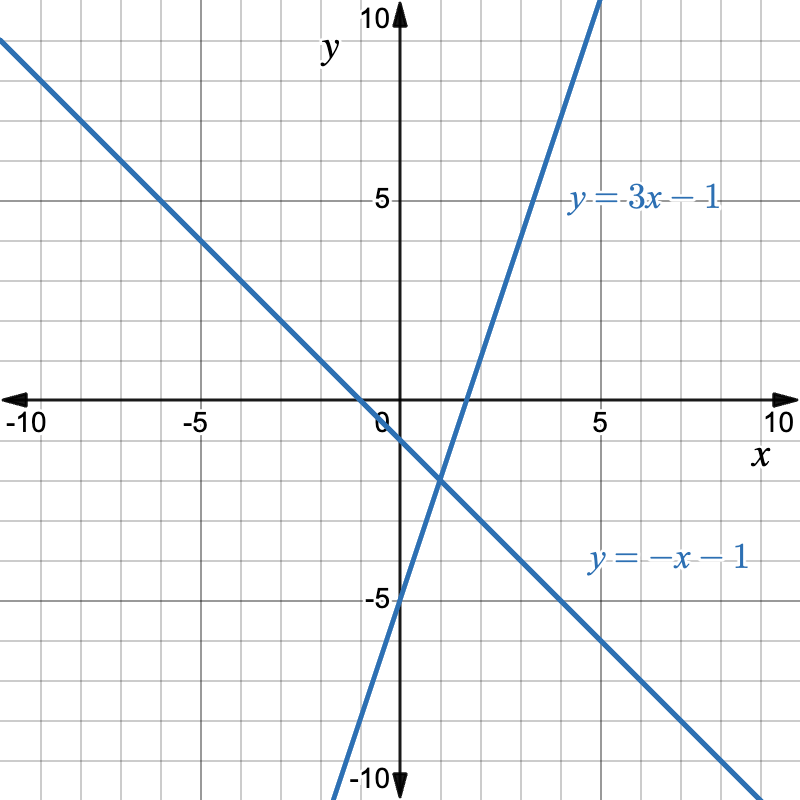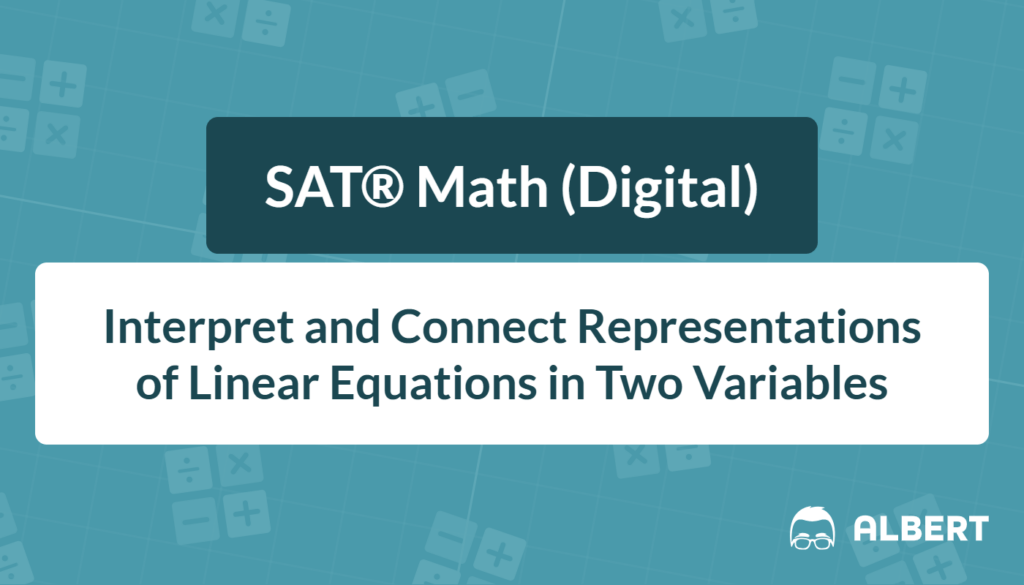Linear equations pop up everywhere – from ride-share fees to science labs. Therefore, the SAT® loves to test them. After exploring this guide, any student can confidently create, interpret, and connect two linear equations with two variables, as well as related tables and graphs. The result: faster answers and fewer careless errors on test day.
What We Review
Introduction
Linear equations in two variables appear in at least four of every ten SAT® Math questions. However, the good news is that the same small set of skills unlocks them all. This guide shows how to interpret linear equations in two variables, write models from words, and connect representations of linear equations with ease.

What Makes an Equation “Linear”?
An equation is called linear when each variable has degree 1. Consequently, its graph is a straight line—imagine a perfectly paved road on a map. Every linear graph is determined by two simple ingredients:
- slope, which measures tilt
- y-intercept, where the line meets the y-axis
Example
Is y = 7x^2 + 3 linear?
Observe the exponent on x is 2, not 1. Therefore, the degree is 2. Thus, the equation is quadratic, not linear.
Core Formulas & Vocabulary
- Slope-Intercept Form
- y = mx + b
- m = slope, b = y-intercept
- y = mx + b
- Point-Slope Form
- y - y_1 = m(x - x_1)
- Useful when one point and the slope are known.
- y - y_1 = m(x - x_1)
- Standard Form
- Ax + By = C
- A, B, C are integers, and A should not be negative.
- Ax + By = C
Example
Convert 3x - 2y = 10 to slope-intercept form.
| Step | Reason |
|---|---|
| 3x - 2y = 10 | Original equation |
| 3x\color{red}{ - 3x} - 2y = 10\color{red}{ - 3x} | Subtract 3x from both sides |
| -2y = -3x + 10 | Simplify |
| \dfrac{-2y}{\color{red}{-2}} = \dfrac{-3x + 10}{\color{red}{-2}} | Divide both sides by -2 |
| y = \dfrac{3}{2}x - 5 | Final answer in slope-intercept form ✅ |
Therefore:
- slope m = \frac{3}{2}
- y-intercept b = -5.
Creating a Linear Model from a Word Problem
Step-by-Step Framework
- Identify variables (what changes?).
- Translate relationships into math.
- Write the equation in a convenient form, often slope-intercept.
Example: Renting a Kayak
A lakefront shop charges a flat launch fee of \$8 plus \$12 per hour to rent a kayak. Write an equation that models total cost C in dollars after h hours.
Step 1: Identify the quantities
The two quantities are time in hours (h) and total cost in dollars (C).
Step 2: Define the variables
Let h represent the number of hours the kayak is rented, and let C represent the total cost.
Step 3: Determine the rate and starting value
The rate (slope) is \$12 per hour, and the starting value (intercept) is the flat launch fee of \$8.
Step 4: Write the equation
Using slope-intercept form, the equation is C = 12h + 8.
The equation C = 12h + 8 models the total cost to rent a kayak for h hours.
Interpretation
- Slope m = 12, or the price per hour.
- Intercept b = 8, or the launch fee before any hours are used.
Interpreting Parts of an Equation
Seeing the structure can save time on SAT® Math linear equations. In y = 0.25x + 15, look for:
- Coefficient 0.25 → unit cost or rate of change
- Constant 15 → starting amount
Example: Phone Data Plan
A monthly phone plan charges according to P = 2.5d + 40, where d is data used (GB).
a) What is the base fee?
- The y-intercept is 40, so the base fee is \$40.
b) How much for each additional GB?
- The slope is 2.5, so \$2.50 per GB.
c) If 6 GB is used, find the total cost.
- Substitute d = 6.
- P = 2.5(6) + 40 = 55
- Therefore, \$55.
Finding Missing Values
Given one variable, substitute to find the other. However, always confirm that the value lies in the allowed domain.
Example
For 5x + 2y = 20, find y when x = 3.
| Step | Reason |
|---|---|
| 5x + 2y = 20 | Original equation |
| 5(3) + 2y = 20 | Substitute x = 3 |
| 15 + 2y = 20 | Simplify |
| 15\color{red}{ -15} + 2y = 20\color{red}{ -15} | Subtract 15 from both sides |
| 2y = 5 | Simplify |
| \dfrac{2y}{\color{red}{2}} = \dfrac{5}{\color{red}{2}} | Divide both sides by 2 |
| y = \dfrac{5}{2} | Final answer ✅ |
Connecting Representations of Two Linear Equations with Two Variables
From Table to Equation
- Compute the slope.
- Use any point to solve for the intercept.
Example
| x | y |
| 1 | 4 |
| 3 | 10 |
- Slope m = \frac{10-4}{3-1}=\frac{6}{2} = 3.
- Use point (1, 4):
- 4 = 3(1) + b \Rightarrow b = 1
- Equation: y = 3x + 1.
From Equation to Graph
For y = -\frac{1}{2}x + 4:
- Plot (0, 4) on the y-axis.
- Because slope = -\frac{1}{2}, move down 1 and right 2 to get a second point.
- Draw the line through both points using a straightedge.
From Graph to Equation
Example
A line passes through (0, 3) and (4, 1).
- Slope: m = \frac{1 - 3}{4 - 0} = -\frac{1}{2}.
- Point-slope form with (0, 3):
- y - 3 = -\dfrac{1}{2}(x - 0)
- Simplify to slope-intercept:
- y = -\dfrac{1}{2}x + 3.
How Changes in the Equation Move the Graph
- Increasing m tilts the line steeper.
- Decreasing m flattens it.
- Raising b shifts the line up; lowering b shifts it down.
Writing an Equation from Limited Information
To write a line, choose the quickest path:
- Two points → find slope, then intercept.
- One point + slope → point-slope form.
- Parallel line → same slope.
- Perpendicular line → negative reciprocal slope.
Example: Parallel Line
Find an equation of the line parallel to 3x - 2y = 6 that passes through (1, –4).
First, convert to slope-intercept to find slope.
| Step | Reason |
|---|---|
| 3x - 2y = 6 | Original equation |
| 3x\color{red}{ - 3x} - 2y = 6\color{red}{ - 3x} | Subtract 3x from both sides |
| -2y = -3x + 6 | Simplify |
| \dfrac{-2y}{\color{red}{-2}} = \dfrac{-3x + 6}{\color{red}{-2}} | Divide both sides by -2 |
| y = \dfrac{3}{2}x - 3 | Final answer in slope-intercept form ✅ |
Next, use point-slope form with (1, –4). Convert it back to slope intercept form.
y + 4 = \dfrac{3}{2}(x - 1)| Step | Reason |
|---|---|
| y + 4 = \dfrac{3}{2}(x - 1) | Original equation (point-slope form) |
| y + 4 = \dfrac{3}{2}x - \dfrac{3}{2} | Distribute \frac{3}{2} to both terms in parentheses |
| y + 4\color{red}{ - 4} </span>= \dfrac{3}{2}x - \dfrac{3}{2}\color{red}{ - 4} | Subtract 4 from both sides |
| y = \dfrac{3}{2}x - \dfrac{11}{2} | Final answer in slope-intercept form ✅ |
Therefore, the required parallel line is y = \dfrac{3}{2}x - \dfrac{11}{2}.
SAT®-Style Practice Question Set
- A taxi ride costs \$3.50 to enter the cab and \$1.80 per mile. Write an equation for total cost C after m miles.
- For y = 5x - 7, what is the x-intercept?
- Two lines are perpendicular, and one has equation y = -\dfrac{2}{3}x + 4. What is the slope of the other?
Solutions
- C = 1.80m + 3.50
- Set y = 0: 0 = 5x - 7 \Rightarrow x = 1.4.
- Slope is the negative reciprocal: \dfrac{3}{2}.
Quick Reference Chart: Must-Know Vocabulary
| Term | Definition | SAT® Tip |
| Slope (m) | Ratio of vertical change to horizontal change, m = \dfrac{\Delta y}{\Delta x} | Parallel ⇒ equal slopes; perpendicular ⇒ negative reciprocals. |
| y-intercept (b) | Point where a line crosses the y-axis, coordinates (0, b) | Often reveals fixed fees or starting amounts. |
| Standard Form | Ax + By = C with integer coefficients | Quickly find intercepts by setting one variable to 0. |
| Parallel Lines | Lines that never meet; equal slopes | When rewriting, match the m. |
| Perpendicular Lines | Lines crossing at 90^\circ; slopes multiply to –1 | Flip and negate the given slope. |
| Rate of Change | Another name for slope in context problems | Units help identify which quantity is independent. |
Lightning Review & Key Takeaways
- Linear = degree 1, straight line.
- Slope-intercept form “y = mx + b” is fastest for graphing.
- Interpreting context: slope = rate, y-intercept = start value.
- Tables, equations, and graphs tell the same story—translate among them fluently.
Call to Action
Practice daily with additional SAT® Math linear equations to solidify speed and precision. Confidence grows each time another representation is connected and interpreted.
Sharpen Your Skills for SAT® Math (Digital)
Are you preparing for the SAT® Math (Digital) test? We’ve got you covered! Try our review articles designed to help you confidently tackle real-world SAT® Math (Digital) problems. You’ll find everything you need to succeed, from quick tips to detailed strategies. Start exploring now!
Need help preparing for your SAT® Math (Digital) exam?
Albert has hundreds of SAT® Math (Digital) practice questions, free response, and full-length practice tests to try out.









